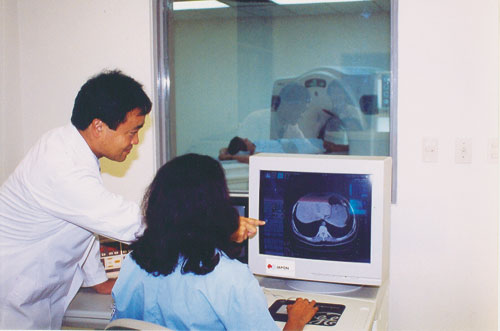Japan's Official Development Assistance White Paper 2005
Column II-3 "Hospital de los japoneses" (Japanese hospital) in the Dominican Republic

Gastrointestinal disease center
The Luis E. Aybar Hospital in the Dominican Republic, an island country in the Caribbean, has been providing free medical services to low-income earners since its establishment in the capital city of Santo Domingo in 1946 and had been expected to contribute to the health improvement of the poor population. However, even though the major cause of infant mortality had been gastrointestinal diseases such as diarrhea, the hospital lacked sufficient equipment and doctors to provide adequate treatment. Specifically, only one gastric camera and four doctors had been available for many years. Consequently, the hospital could only implement the test with medical equipment on about two people per day.
To improve this situation, Japan has been providing assistance to the Luis E. Aybar Hospital since 1989. A gastrointestinal disease center and a medical education center for training medical specialists was built through Japanese grant aid, and Japan dispatched experts to provide technical guidance for diagnostic imaging and so on. Since the gastrointestinal center was completed and the Japanese experts began their activities, the number of patients with gastrointestinal disease increased drastically. Consequently, the required enhancement of the patient information management system has emerged as a major challenge. In the past, the hospital handled patients by simply writing down names and identification numbers in a notebook. As a result, individual patient information was not sufficiently managed and the hospital could not respond appropriately to the sudden increase in the number of patients. To improve this situation, a "one patient-one number-one chart" system was introduced through technical cooperation, based on the patient information management system generally used in Japanese hospitals. Thanks to this system, the hospital can now functionally organize the information of visiting patients.

Transfer of imaging diagnostic technology, which is considered to be at the top level, to the Central American and the Caribbean countries
Through such efforts, the number of patients currently received at the Luis E. Aybar Hospital in one week has greatly increased to almost equal the number previously accepted in an entire year before Japanese cooperation. Because patients are able to receive higher quality service than that of private hospitals, the number of patients from rural areas and the low-income population has increased. In addition, all people of the Dominican Republic are now able to receive more frequent treatment. According to the statistics of the county's Ministry of Welfare and the Luis E. Aybar Hospital, the gastrointestinal disease center has provided medical exams including those requested by other hospitals, to a cumulative total of 4.7 million people over eleven years between 1994 and 2004, while the population of the country is approximately 9 million. Furthermore, the hospital attracts patients from other Caribbean countries, because it has the top-level medical technology now in the area of diagnostic imaging and epidemiology within the Central America and Caribbean region, as a result of technology transfer from Japan.
The Luis E. Aybar Hospital has currently become a symbol for Japan's economic cooperation within the Dominican Republic. When a patient wants to go to the hospital by taxi, it is enough to tell the driver, "Hospital de los japoneses (the Japanese hospital)." The Luis E. Aybar Hospital is expected to become a model medical institution not only for the Dominican Republic, but also for the rest of the Central America and Caribbean region.


 Next Page
Next Page